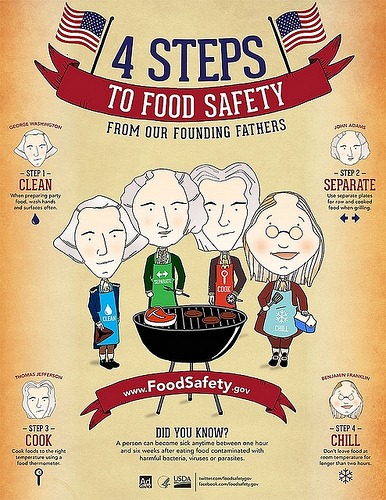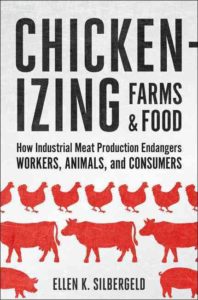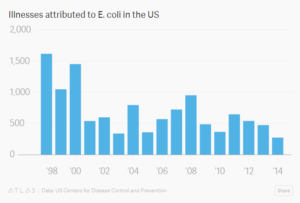Wishing you a safe and sane July 4

From the USDA’s partnership with the Ad Council…
Scott Faber, Vice President of Government Affairs for the Environmental Working Group summarizes Trump’s Full-Scale War on Food. Since taking office, he writes, Trump has:
This is an impressive list, calling for serious resistance.
How? That’s the question….
Food Safety News, my go-to source for information about current and past episodes of foodborne illness, reports the price of insufficient corporate diligence: $36 million in recalls by Dole Foods.
Dole, a privately-held company is going public, which means it has to file lots of financial documents with the Securities and Exchange Commission (SEC). For the past couple of years, these show:
2015: $10.8 million to recall bagged salads in which a sample tested positive for Salmonella.
2016: $25.5 million for a four-month shutdown of a salad processing plant found to be contaminated with Listeria, and manage a recall. Listeria at the plant was linked to four deaths and 33 cases of illness in the U.S. and Canada. The company continued to ship salads from the facility after swab tests were positive for Listeria.
The SEC requires companies to list potential risks. In its SEC filing, Dole said:
We are subject to the risk of product contamination and product liability claims…Even if a product liability claim is unsuccessful or it not fully pursued, the negative publicity surround any assertion that our products caused illnesses or injury could adversely affect our reputation with existing and potential customers and our corporate and brand image. Moreover, claims and liabilities of this sort might not be covered by our insurance or by any rights of indemnity or contribution that we may have against others.
This is why diligent attention to preventive controls is essential for producing safe food.
Not using them kills people; it also is expensive.
Food safety is an issue every meat business takes considerable careover as the financial costs of a recall, not to mention the reputational risk, can be devastating. In this special newsletter, GlobalMeatNews takes a look at the latest recalls, changes to food safety regulation and other key developments across the supply chain.
The congressional watchdog Government Accountability Office (GAO) has just published its latest plea for coordinating federal food safety programs: A National Strategy Is Needed to Address Fragmentation in Federal Oversight.
GAO persists in pointing out that 16 federal agencies administer 30 laws government food safety and quality, although USDA (meat and poultry) and FDA (everything else) have the greatest responsibility.
Despite some progress, GAO’s long-standing recommendation for a single, unified food safety agency continues to be ignored.
HHS’s and USDA’s efforts since 2014 are positive steps toward government-wide planning, but OMB has not addressed our recommendation for a government-wide plan for the federal food safety oversight system. Without an annually updated government-wide performance plan for food safety that includes results-oriented goals, performance measures, and a discussion of strategies and resources…Congress, program managers, and other decision makers are hampered in their ability to identify agencies and programs addressing similar missions and to set priorities, allocate resources, and restructure federal efforts, as needed, to achieve long-term goals. Also, without such a plan, federal food safety efforts are not clear and transparent to the public. OMB staff told us that they were not aware of any current plans to develop a government-wide performance plan for food safety.
The footnotes list previous GAO reports aimed at rationalizing our food safety system, among them:
One of these years, maybe?
Ellen K. Silbergeld. : How Industrial Meat Production Endangers Workers, Animals, and Consumers. Johns Hopkins Press, 2016.

Ellen Silbergeld, a professor of environmental health sciences, epidemiology, and health policy at Hopkins, has long been a strong advocate for getting toxic substances out of our food supply. Here, she takes on our system of industrial farm animal production in a plea for better treatment of everyone and everything involved in it.
Big issue #1: the use of antibiotics as growth promoters. This not only induces bacteria to become resistant to those drugs, but also is unnecessary.
Big issue #2: the failure of HACCP (Hazard Analysis and Critical Control Point—the method for preventing food safety problems) to prevent harmful, antibiotic-resistant bacteria from reaching the public.
Overall, she says:
The inextricable relationship between industrial food animal production and the environment challenges us in two ways. First, we are all at risk–not just those of us who consume the products of industrially raised animals–and second, decontaminating food products will not contain the public health problems of this industry. It is time to think about industrial food animal production as an industry in terms of environmental pollution, and it is long overdue to recognize that its pollution footprint, like its production, is industrial in scale (p. 127).
As for the remedy, “agriculture is an industry, and as such it carries certain obligations.” These include, among others:
She has plenty more to say about government’s role in all this.
Our role is to insist that industry and government follow and apply laws. We had best get busy.
Presidential candidate Donald Trump gave a speech to the Economic Club of New York about his tax reform plan to “make America great again.”
The plan would eliminate some programs he finds annoying, the FDA’s food safety regulations among them.
The tax plan, including the FDA provisions, was posted on Trump’s website, but it is no longer there.
Fortunately, @nycsouthpaw did a screen capture and posted it on Twitter. Among other things, Trump would like to eliminate:
Food safety lawyer Bill Marler, who begs producers of unsafe food to “put me out of business” is getting his wish and notes how well the new food safety rules are working. He says Trump must love him: Killing the FDA is good for business:
How did “The Donald” know that my business has dropped over the last few years as the regulatory work of our governmental agencies have kicked into gear.
Who knew that food safety would be an issue in this year’s election, let alone Skittles.
Chase Purdy writing in Quartz says “The system for catching dangerous pathogens in America’s food supply is finally working.”
Here’s the best evidence: the remarkable decline in cases of STEC (Shigella Toxin E. Coli).

Quartz quotes food safety lawyer Bill Marler: “You look back over time and, from 1993-2003, about 90% of my firm’s revenue was from E. coli cases connected to hamburger.”
What changed? Regulation.
The USDA now considers STEC to be an adulterant and does not permit meat and poultry contaminated with it to be sold.
But then there’s Salmonella. It is not considered an adulterant. Why not? Because it occurs so frequently that USDA considers it normal. Cases of Salmonella have not declined as much as they should.
In the meantime, the FDA is diligently following through on its food safety rulemaking. On August 24, it opened three more sets of draft guidance documents for public comment.
When we were drafting and seeking public comment on the rules that will implement theFDA Food Safety Modernization Act (FSMA), we promised that we would do whatever we could to help the regulated industry understand and meet the new requirements….Meeting the FSMA mandate involves cooperation between the FDA and the food industry. From the smallest food operation to the largest company, we want to be sure that we’re all on the same page and these draft guidances will help get us there.
Onward and upward. This is progress. It would be nice if it went faster but it’s real progress—even if Bill Marler still has plenty of work to stay busy.